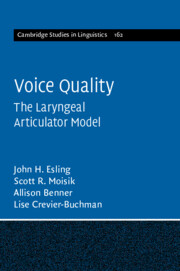Book contents
- Voice Quality
- Series page
- Cambridge Studies in Linguistics
- Voice Quality
- Copyright page
- Contents
- Figures
- Tables
- Preface
- Acknowledgements
- Abbreviations
- 1 Voice and Voice Quality
- 2 Laryngeal Voice Quality Classification
- 3 Instrumental Case Studies and Computational Simulations of Voice Quality
- 4 Linguistic, Paralinguistic, and Extralinguistic Illustrations of Voice Quality
- 5 Phonological Implications of Voice Quality Theory
- 6 Infant Acquisition of Speech and Voice Quality
- 7 Clinical Illustrations of Voice Quality
- 8 Laryngeal Articulation and Voice Quality in Sound Change, Language Ontogeny and Phylogeny
- References
- Author/Artist Index
- Subject Index
2 - Laryngeal Voice Quality Classification
Published online by Cambridge University Press: 21 June 2019
- Voice Quality
- Series page
- Cambridge Studies in Linguistics
- Voice Quality
- Copyright page
- Contents
- Figures
- Tables
- Preface
- Acknowledgements
- Abbreviations
- 1 Voice and Voice Quality
- 2 Laryngeal Voice Quality Classification
- 3 Instrumental Case Studies and Computational Simulations of Voice Quality
- 4 Linguistic, Paralinguistic, and Extralinguistic Illustrations of Voice Quality
- 5 Phonological Implications of Voice Quality Theory
- 6 Infant Acquisition of Speech and Voice Quality
- 7 Clinical Illustrations of Voice Quality
- 8 Laryngeal Articulation and Voice Quality in Sound Change, Language Ontogeny and Phylogeny
- References
- Author/Artist Index
- Subject Index
Summary
Laryngeal voice quality classifications and ‘states of the larynx’ are reviewed and expanded. Supplementary notes accompanying the text describe the video, audio, and text materials in the online companion site that accompanies the book to illustrate and explain the articulatory production of each laryngeal voice quality. Constricted phonation types exploit degrees of laryngeal articulator tightening with concomitant lingual and larynx-height settings. A new continuum of laryngeal stricture, from open to closed, is introduced. Glottal, ventricular, and epiglottal stop are illustrated. Breathiness vs. whisperiness is redefined. Creaky voice and varieties of harsh voice are investigated, including ventricular production and trilling of the aryepiglottic folds. New drawings and laryngoscopic photographs capture the extent of open and constricted postures. Breathy states with and without voicing are compared side by side with whispery states. The concept of vocal tract tension is reattributed to constrictive settings of the laryngeal articulator mechanism. The aim is to paint an auditory portrait of the articulatory configurations of the vocal tract.
Keywords
- Type
- Chapter
- Information
- Voice QualityThe Laryngeal Articulator Model, pp. 37 - 82Publisher: Cambridge University PressPrint publication year: 2019



